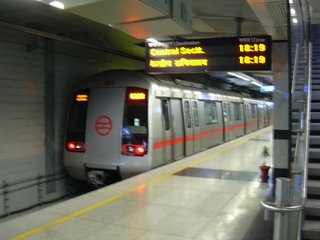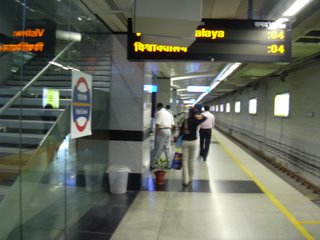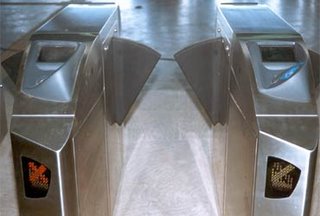








early last week,i was in delhi for two days.on the second day, i found some spare time and utilised it to travel in the metro about which i had heard a lot of praise. i must admit that i was very impressed with everything. the stations were spic and span(no eatables are allowed),the security very alert,the ticketing all done electronically, very user- friendly and fast. the compartments were absolutely clean.each train has four coaches with a seating capacity of 240 seats and 300 passengers can stand in.all the four coaches are interconnected. a temperature of about 27 deg celsius was maintained.the acceleration and deceleration was high, the doors closed automatically. there is no place for keeping any luggage though.there is a talk-back speaker system for security.
i learnt that about 63 km or so has now been covered by the delhi metro,which includes underground,groundlevel as well as elevated railtravel. the running speed is about 50mph. the stations are very spacious and security guards are helpful.tickets are not very expensive.there are escalators in the stations for fast and convenient entry and exit.there are no graffitis on the walls anywhere! stations have carparking lots and shopping complexes. atms,food outlets,coffee shops etc. with 2 million commuters travelling every day, this 2 billion euro project has become viable after about four years.
delhi metro corporation limited was specifically formed to setup and run the metro. in dec 2002,the first phase became operational. for phase 2 covering 77 kms,work is in progress and is expected to be completed by 2010.hyundai motor is in the race for supplying 400 trains for a value of about rs 2300 crores.on completion,air travellers can reach the indira gandhi international airport in 16 minutes from new delhi station.
the metro in delhi is operational between 6am and 10 pm and at a frequency of 4 minutes at peak time.the stoppage time at each station is about 20 seconds.i travelled patel chowk to kashmere gate and from there to indralok and returned by the same route.the system map,ticket and fare information are prominently displayed.there are special lifts for senior citizens and the disabled.just like in london you have the red line,blue line and yellow lines. shahdara-rithala(22km) is the red line. vishvavidyalaya-central secretariat(11kms) is the yellow line and indraprastha- dwarkasubcity(29km) is the blue line.public announcements are clear and easy to understand. for cities like chennai,kolkata,bangalore, mumbai and delhi having huge populations, a metro is a must and must be factored into public tranportation systems and land-use planning. it is energy-efficient,non-polluting and definitely more reliable than land-based transport and can complement it for mass rapid transport.
dmrc has done a great job.by adopting world-class technologies in construction,erection and maintenance of a mass transport system, they have made the delhi metro as good as anywhere else in the world.the delhiites are justifiably proud of their metro. for them it is a dream come true.it saves time,is comfortable and is safe. and one can see that in the efforts they make to keep it clean .
e.sreedharan,73,the grand old man of indian railways,and the architect of konkan railways, has again proved that we are capable of creating engineering marvels.sometime back united states' engineering news featured him and branded him as the person who can 'knock down' any hurdle. prince charles visited the delhi metro in october 2003 and was full of praise for the magnificent work done by the indian engineers.
metros are generally financially unviable propositions.highly capital intensive,this mass transport system takes many years to break even if at all.most international metros do not turn in any profits.but if the overall economic benefit to society is considered,the returns will start happening from 4 to 5 years as shown by dmrc. extensive real estate developments if undertaken as part of the project on surplus government and semi-government lands can help in metros becoming viable.also goverment should extend concessions such as remission of import duty,vat exemption etc. to reduce capital costs.dmrc have by their unique and innovative management practices already made the delhi metro viable.this is no mean an achievement.
they may even soon offer you a room to stay.dmrc is earmarking some of its land for the hospitality sector. plans for budget and star-rated properties are on the anvil. with commonwealth games slated for 2010, delhi will have to do some quick catching up as it is having a shortage of about 60,000 rooms annually.
recently dmrc invited suggestions from the public to improve the functioning and services of the metro.this is perhaps the first time in india that a public transport system has invited suggestions from the public.
next time you are in delhi, don't miss travelling by the metro.it is as good as anywhere else in the world. if not better.

2 comments:
very interesting post, appa. really enjoyed your write-up. thanks for taking all the great photos as well.
when is the bombay metro going to happen?
well only end of last month cm gave his stamp of approval for the 31.87 km second corridor of the mumbai metro project estimated to cost about rs 6200 crores.the total project cost is about rs 20,000 crores.the second corridor is charkop-bandra-mankhurd.it is expected to be completed by 2011.the first corridor is the 12km versova-andheri-ghatkopar route.the original plan of colaba-charkop has been changed as it is unviable. a 5.6 km long bandra-worli sealink is in progress and moving at snail's pace.
Post a Comment